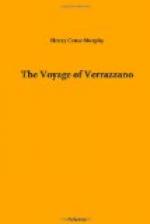II.
THE VERRAZZANO LETTER NOT GENUINE
No proof that the letter ascribed to Verrazzano, was written by him, has ever been produced. The letter itself has never been exhibited, or referred to in any authentic document, or mentioned by any contemporary or later historian as being in existence, and although it falls within the era, of modern history, not a single fact which it professes to describe relating to the fitting out of the expedition, the voyage, or the discovery, is corroborated by other testimony, whereby its genuineness might even be inferred. The only evidence in regard to it, relates to two copies, as they purport to be, both in the Italian language, one of them coming to us printed and the other in manuscript, but neither of them traceable to the alleged original. They are both of them of uncertain date. The printed copy appears in the work of Ramusio, first published in 1556; when Verrazzano and Francis I, the parties to it, were both dead, and a generation of men had almost passed away since the events which it announced had, according to its authority, taken place, and probably no one connected with the government of France at that time could have survived to gainsay, the story, were it untrue.[Footnote: Verrazzano died in 1527; Louise, the mother of Francis I in September, 1582, and Francis himself in March, 1547.] Ramusio does not state when or how he obtained what he published. In the preface to the volume in which it is printed, dated three years before, he merely speaks of the narrative incidentally, but in a discourse preceding it, he obscurely alludes to the place where he found it, remarking that it was the only letter of Verrazzano that he had “been able to have, because the others had got astray in the troubles of the unfortunate city of Florence.” The origin of the manuscript version is equally involved in mystery. It forms part of a codex which contains also a copy of a letter purporting to have been written by Fernando Carli, from Lyons to his father in Florence, on the 4th of August, 1524, giving an account of the arrival of Verrazzano at Dieppe, and inclosing a copy of his letter to the King. The epistles of Carli and Verrazzano are thus connected together in the manuscript in fact, and by reference in that of Carli, making the copy




